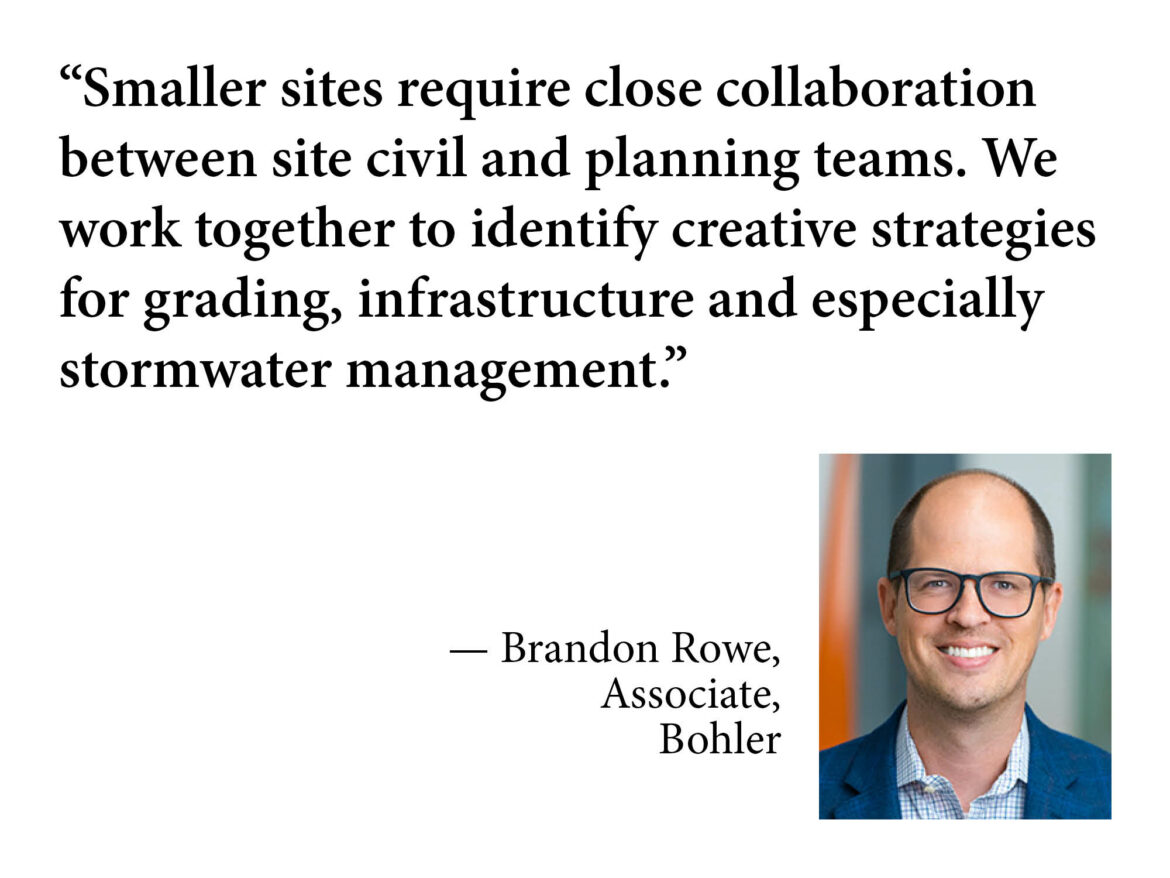As the demand for senior living communities continues to rise, so does the complexity of designing environments that meet the evolving needs of residents across the entire continuum of care. Facilities that seek to cater to independent living, assisted living, memory care, skilled nursing and rehabilitation needs must strike a balance: fulfilling stringent functional and regulatory requirements while remaining inviting, promoting connection to nature and others and offering comfort for people of all ages and abilities.

Bohler
The biggest challenge, according to designers and seniors housing experts alike, is “seamlessly weaving protective elements, like perimeter security or grade changes, into a design that feels warm and inclusive, not institutional,” explains Adam Alexander, director of planning, landscape architecture and design at Bohler, a land development design and consulting firm. “Features like fences or bollards don’t need to be emphasized as one-note safety features. They should be invisible contributors to a resident’s experience of comfort and care.”
An overall trend toward smaller sites for seniors housing means that continuum of care communities are innovators in inclusive and multi-purpose space use. They may also serve to address increasing calls for solutions to the loneliness epidemic ongoing in the lives of many adults.
While less square footage may present design challenges, this compact scale can naturally foster human connection. Designers and developers can encourage more frequent, spontaneous interactions through thoughtfully concentrated communal spaces and stronger visual ties between residents and shared amenities.
Creativity on Constrained Sites
With land availability shrinking and costs climbing, many projects are being built on smaller and more challenging sites. These include adaptive reuse, mixed-use, phased projects and, of course, sites that are simply more compact. This overall trend demands increased creativity from project teams.
“Smaller sites require close collaboration between site civil and planning teams,” says Brandon Rowe, an associate in Bohler’s Baltimore office. “We work together to identify creative strategies for grading, infrastructure and especially stormwater management.” To accommodate all necessary functions on smaller sites, teams are turning to strategies like structured parking, vertical construction, multipurpose outdoor zones and integrating stormwater management facilities into amenity spaces. Landscape architects and designers are layering uses: walking paths can serve as an easy connection to nature, a route for exercise and a place to interact. Planters can serve as both aesthetic elements and vehicle barriers, while raised beds may limit resident access in some directions and offer opportunities for community gardening.
Grade changes and landscaping are also pulling double duty. Instead of fencing, gentle berms with dense plantings can define boundaries in a softer, natural way. “You don’t always need a visible wall to create separation,” says Alexander. “A well-placed retaining wall with a railing or a slope buffered by trees can feel less like a barrier and more like part of the landscape.”
Additionally, rain gardens, permeable pavement, bioswales or other stormwater management structures can be used to create buffers and borders, while directing (and sometimes treating) rainwater. Stormwater management regulations are increasingly trending toward multiple, smaller facilities instead of one large facility. Design teams need to get creative, especially on smaller sites, to maximize space and incorporate stormwater into the design.
Finally, positioning entrances and parking lots to prioritize pedestrian-friendly access, make moving in/out easier and preserve views from each unit helps create a more inviting, residential atmosphere while maintaining safety and operational efficiency.
Design for All Ages and Abilities
The range of users in a continuum of care community is vast across independent living, assisted living, memory care, skilled nursing and rehabilitation. Plus, design must also cater to the needs of loved ones and staff.
Drawing inspiration from hospitality, multifamily and student design can help continuum of care communities feel less institutional. These approaches instead evoke the comfort and welcome of a hotel or a lively apartment building. Thoughtful material selections, inviting lobbies and amenity-rich environments can elevate the resident experience and support a sense of independence and dignity.
Each group brings different physical needs, expectations and energy levels. Yet, as Alexander notes, “Regardless of age, people generally want the same things: opportunities to connect, relax and engage with their environment and one another.”
From a site design perspective, this means creating intuitive paths, accessible grades and welcoming social nodes that accommodate walkers and wheelchairs as easily as strollers. Rowe emphasizes that amenities play a critical role here: The best designs foster person-to-person interaction naturally, whether that’s through cozy seating areas tucked under trees, gardens that offer both beauty and sensory stimulation or outdoor social spaces that serve as venues for exercise, classes, therapy and relaxation.
An additional element that may promote health and safety is wayfinding, the process of making spaces easy to navigate. Design materials, signs, colors and grading can all signal to residents where to go and reinforce recollection.
“Being thoughtful about how the site or the project is designed and how people use the space is critical,” says Alexander. “As a designer, you have to ask how residents function and navigate their way through areas to implement the vision for continuum of care facilities. There’s no need to pick out lavish materials. You want textures and colors and overall design that encourages people across all ages and abilities to seek out communal areas.”
Early Collaboration is Key
Building a successful seniors housing community requires strategic, early collaboration. At Bohler, planners, engineers and landscape architects work together from the outset to align goals, identify site constraints and lay the groundwork for long-term flexibility.
“Time and money are the two things developers care most about,” says Rowe. “That’s why our collaborative due diligence process starts early; we can identify grading challenges, stormwater management requirements, entitlements strategies and traffic impacts before they become bottlenecks.”
In one recent project, Bohler helped a client accelerate the timeline for a seniors housing conversion by separating building renovations and outdoor improvements into two distinct permitting tracks. “We ran the building permits first so construction could start while we continued permitting the exterior site work,” explains Rowe. “It allowed move-ins to begin months earlier.”
Designing With the Future in Mind
Ultimately, successful continuum of care design must look beyond immediate needs. Projects are often phased, and infrastructure decisions made today (where to run utility lines, place access roads, etc.) can either enable or hinder future expansion.
Flexibility is also critical in program development. As resident preferences evolve, spaces must adapt. This process could entail retrofitting, repurposing amenities for new activities, accommodating increasing demand for memory care or planning for a phased building process to minimize disruption for residents.
Across generations, expectations are changing, and many developers are now drawing inspiration from mixed-use, hospitality and multifamily housing models to shape more vibrant, socially connected communities.
“Our collective experience in these other sectors helps our teams collaborate on innovative site layouts and creative designs,” explains Rowe. “Exposure to these other property types means we’re well-versed in creating amenities that increase the functionality of the site and create value for the client. For example, a rain garden might simultaneously function as an amenity space and a stormwater facility, merging regulatory necessity with a benefit for residents.”
“It’s an exciting challenge,” says Alexander. “Our goal is to create places that people want to live in, because they feel supported, safe and engaged at every stage of life.”
—Bohler is a content partner of REBusinessOnline. For more articles from and news about Bohler, click here.


